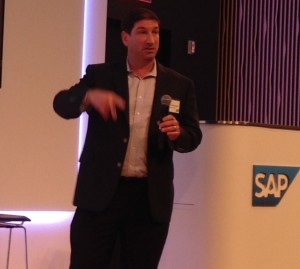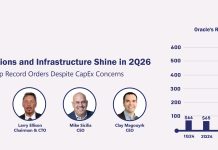SAP is spinning up its financial and ERP applications strategy in order to become more entrenched with its biggest customers, a move that could redefine their system landscape as much as its own future.
At the heart of its strategy lies the core back-office systems being used by top multinationals to handle a smattering of accounting, finance, treasury and risk management functions across 21 verticals from oil and gas to chemicals and from services to manufacturing.
With a number of new products and value-added packaging options in a two-pronged strategy, SAP is aiming to lure thousands of its loyal customers to the latest Cloud and on-premise financial accounting and Enterprise Performance Management applications.
If it succeeds, SAP could extend its lead in the enterprise applications market for a decade or more as many of these products are so mission critical that few companies have the resources or reasons – both financial and technical – to invest or upgrade these new systems and in most cases doing it only once every 10 to 20 years.
If it fails, SAP could see its dominance start slipping as a clutch of ISVs – both on-premise and Cloud-only – gain ground by snowballing their newfound popularity that could ultimately alter the competitive landscape for years to come.
The stakes are enormous. The Enterprise Resource Planning(ERP) applications market, which covers both financial management and EPM functions, is projected to jump to $44 billion in product revenues by 2019, up from $36 billion in 2014. Financial management and EPM applications are expected to account for at least one third of the market through the forecast period.
However much of the growth is likely to come from Cloud subscriptions, soaring from $4.2 billion to $9.5 billion, as shown in the following table.
ERP Applications Market Forecast 2014-2019, By Revenue Type, $B
| Revenue Type, $B | 2014 | 2019 |
|---|---|---|
| License | 8.0 | 9.0 |
| Maintenance | 23.0 | 26.0 |
| Cloud Subscription | 4.2 | 9.5 |
| Total | 36.2 | 43.5 |
Source: Apps Run The World, September 2015
SAP continues to derive the bulk of its revenues(85% in the third quarter of 2015) from on-premise products, though its Cloud subscriptions and bookings have jumped considerably following a series of acquisitions.
In order to sustain its No. 1 position in the ERP market with an estimated 21% share, SAP has embarked on a number of initiatives to protect its franchise.
Leading the charge is SAP S/4HANA Finance, formerly known as Simple Finance, an one-year-old product that is part of the latest rendition of its ERP package S/4HANA.
S/4HANA Finance has become the focal point of more than 300 active projects(compared with 50 last year) among its key customers such as New York Life, Florida Crystals, and GE Energy. Twenty five of these projects have gone live. S/4HANA has been purchased in as many as 1,000 software license transactions.
At a two-day conference held recently at its North America headquarters in Newtown Square, PA, SAP outlined its financial transformation journey in front of about 100 key accounts. Combining vision talk and customer narratives, the SAP Financial Excellence Forum drove home the message that what’s possible in S/4HANA Finance for some could be replicated by others.
Of the 300 active projects now under way by customers of S/4HANA Finance, some involve tax management(think reducing tax burden through global analysis of rules and regulations), while others are geared toward M&A, divestiture modeling and corporate restructuring.
Active Projects at NY Life, GE
Relying on S/4HANA Finance, New York Life is in the midst of a four-year financial transformation project that covers everything from centralized GL to integrated business budgeting and from acquire to retire processes in asset management, as well as a bevy of planning and forecasting programs that could give the life insurer not just a single version of truth, but also a significant boost to its financial and workforce planning efforts through 2017 and beyond.
GE Measurement and Control, a unit of GE Energy, has launched a proof of concept project that leverages S/4HANA Finance to do such things as product line profitability directly from ledger, COGS by cost component split in FI, as well as faster specific close transactions.
Instead of positioning it as the latest ramp-up product for ERP upgrades and rapid implementations. S/4HANA Finance is geared toward organizations – especially those that for the past decade have underinvested in their system landscape – with a fresh template for new design thinking.
Whether one calls it financial transformation or boardroom of the future, the goal is the same as other groundbreaking forces like Tesla’s fast and sleek electric cars and Apple’s world-class design and functional smartphones.
In a sense, SAP is breaking the barriers that have made system silos a common occurrence among its customers as many have settled on multiple instances of SAP ERP through considerable modifications. Their stable financial accounting system has served them well, but it’s also putting them at odds with an agile and flexible way of doing their books, or for that matter conducting their business in a fast-changing world that increasingly demands real-time reporting and quick decision making without the luxury of long-term planning.
With the use of in-memory database as a prerequisite that eliminates indices and aggregates for smaller data footprint, S/4HANA Finance expands the reach of the dull and essential financial accounting system because the physical database and the analytics that goes along with it to deliver financial insight can be done in a single box. Systems from its rivals, on the other hand, are still doing it in piece meal resulting in latency, increased overhead and even bottlenecks.
It’s one thing that most companies want to emulate Tesla or Apple favoring their speed, design and innovation. It’s something else altogether to reinvent their business processes in order to accommodate a new design thinking.
Then there’s the issue of business process outsourcing for different functions from procurement to finance(think teams of college graduates carrying out the tedious chores of account reconciliation manually in offshore centers like Bangalore).
At first glance, it may be an excellent idea to run S/4 HANA Finance in order to give the CFO a glossy picture of company health with very little friction in terms of account reconciliation, line by line budgeting, real-time planning, etc.
The picture looks less promising when one takes into account of the considerable costs of licensing the software, retasking one’s BPO partners(which may still need to handle the grunt work of data entries manually), and perhaps doing it multiple times across different regions.
At the SAP event, an IT director responsible for finance automation function at a big pharmaceutical company with five separate instances of SAP ERP as well as a long-term contract with an offshore BPO partner told me the above picture is what prompted him to question the value of S/4HANA Finance.
Yes, transformation is good for a lot of companies. But few are ready to make the plunge. In fact, many attendees at the SAP event were non-committal when asked about their intentions of pursuing a S/4HANA Finance project.
With more than 50,000 ERP customers under its belt, SAP has many opportunities to help make such financial transformation a reality even though the journey could be long and difficult for some. Even with a few hundred active projects including some that could take more than a year just to hash out the scope of the proof of concept project, it will be quite some time before S/4HANA Finance can build a critical mass.
Cloud For Analytics
That’s where the second part of its two-pronged strategy comes in. On the same day when the event was held, the vendor announced that it would make SAP Cloud for Analytics available to its customers in an all-in-one package that encompasses business intelligence, planning, budgeting and predictive capabilities via Cloud delivery.
Already, SAP Cloud for Planning, which was announced last year, and SAP Lumira for visualization are key components readily available within SAP Cloud for Analytics. At a breakout session during the event, SAP said Cloud for Predictive Analytics for simulation and Governance, Risk and Compliance will become standard features in SAP Cloud for Analytics in 2016.
If S/4HANA Finance is not capable of winning a critical mass – anything approaching 3,000 customers – over the next few years, SAP Cloud for Analytics could be the near-term solution for its target audience that has seen an onslaught of Cloud tools for a range of tasks from BI to Enterprise Performance Management as well as budgeting, planning and consolidation across finance, HR, sales, and supply chain functions.
Budgeting, Planning and Consolidation, or BPC in SAP’s financial management product strategy, has been a key tenet of its Business Analytics strategy following the acquisitions of OutlookSoft and BusinessObjects in 2007.
Since that time, SAP has increased wallet share among its financial management customers with a number of BI, analytics and planning applications adding incremental value to FI, FICO, COPA, SD, PI and SEM, all of which are modules within its ERP suite. Before SAP made those acquisitions, its SEM for strategic enterprise management had about 2,000 customers. Today, BPC, which encompasses brands like OutlookSoft, Cartesis as well as SEM, has about 10,000 customers.
In the aftermath of the 2008 financial crisis when wholesale changes to one’s ERP systems were drying up, SAP Business Analytics was instrumental in forestalling a total collapse in its software license revenues.
The emergence of Cloud-based BI and EPM vendors such as Anaplan, Birst, Domo and others has begun to shake up the business analytics market. The ease of use of their BI tools and the quick consumption pattern of the Cloud have helped a host of new Cloud vendors attract a growing number of customers particularly among line of business users. With the past year, vendors like Domo have signed more than 1,000 customers after raising hundreds of millions of dollars in financing, as shown in the following table.
Major OnPremise, Cloud BI and EPM Vendors
| Money Raised, $M | Estimated No. of Employees | Estimated No. of Customers | |
|---|---|---|---|
| Adaptive Insights | 100 | 450 | 2800 |
| Anaplan | 150 | 450 | 400 |
| Birst | 156 | 250 | 1000 |
| Domo | 450 | 700 | 1000 |
| Host Analytics | 77 | 250 | 500 |
| IBM Cognos | Public | 379000 | 20000 |
| Oracle Hyperion | Public | 135070 | 8000 |
| SAP BPC | Public | 74500 | 10000 |
| Tidemark | 100 | 150 | 100 |
Source: Apps Run The World, September 2015
IBM has recently made Cloud EPM part of its analytics offerings, while Oracle has trumpeted its EPM Cloud Service a key differentiator over other ERP vendors because of easy on-ramp, lower IT resource requirements and accelerated time to value. Now with SAP Cloud for Analytics, all three incumbent on-premise EPM vendors are duking it out over their future relevance as the world turns to the Cloud.
In this new world of financial management, SAP’s position appears to be for any organization that needs to do such tasks as budgeting and allocation not to mention central G/L, the default solution is S/4HANA Finance because it can automatically spit out data directly from one’s ERP backend for real-time and so-called Integrated Business Planning, all done without the need for periodic updating. That’s where the path that most of these 10,000 BPC customers could take.
However as some of them may want to achieve faster results without enduring the potentially long and arduous journey of upgrading the entire G/L to S/4HANA Finance, SAP Cloud for Analytics could be a viable alternative especially for those that choose to stay within the SAP environment.
As a time when more decision-making is being made in the front lines and LOB managers are capable of amassing more financial data and other metrics at their fingertips, the ad-hoc modeling, real-time planning and what-if requirements will become more common than ever.
The question is whether these LOB users should be given those modern tools as the recipe for quick fixes, or under the directive from their CFO to build out a new system in a full-throttle campaign for financial transformation. In either case, the decision by SAP customers to do one over the other will have serious implications not just for the vendor, but also the future of the enterprise applications marketplace.






